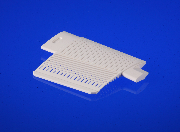Dieter Steudtner, sales manager at Morgan Advanced Materials, looks into the benefits and properties of advanced ceramics.
Today’s advanced ceramics offer strong physical, chemical and electrical properties that make them highly resistant to melting, bending, stretching, corrosion, wear, high voltages and currents.
They provide a cost-effective, high performance alternative to traditional materials, with new materials constantly being developed and engineered to address the needs of individual applications.
Physical properties such as strength, hardness, wear resistance, corrosion resistance and thermal stability must be considered when choosing a material.
Alumina
Offering a combination of good mechanical and electrical properties, alumina is suitable for applications including laser devices, x-ray tubes, electron tubes, aerospace devices, high vacuum applications, flow meters, pressure sensors, and wear components. It has a good strength and stiffness, good hardness and resistance to wear. Alumina is available in grades ranging from 60% to 99.9% with additives designed to enhance properties such as wear resistance or dielectric strength. Formed using a variety of processing methods, it can be processed net-shaped or machined to produce various sizes and shapes. It can also be readily joined to metals or other ceramics using specially developed metallising and brazing techniques.
Aluminium Nitride (AlN)
Aluminium nitride (AlN) has excellent thermal conductivity, thermal shock resistance and corrosion resistance and is used in power electronics, aeronautical systems, railways, opto-electronics, semiconductor processing, microwave and military applications. Typical applications include heaters, windows, IC-packages and heat sinks.
Zirconia
Zirconia offers chemical and corrosion resistance at high temperatures up to 2400°C. In its pure form, crystal structure changes limit use in mechanical/temperature applications, but zirconia stabilised with calcium, magnesium or yttrium oxide additives can produce materials with very high strength, hardness and in particular, toughness.
 Silicon Nitride
Silicon Nitride
Silicon nitride has excellent high-temperature strength, creep and oxidation resistance, while its low thermal expansion coefficient provides good thermal shock resistance when compared with most other ceramic materials. It has high fracture toughness, hardness, chemical and wear resistance, and is manufactured in three main product types: reaction bonded silicon nitride (RBSN), hot pressed silicon nitride (HPSN) and sintered silicon nitride (SSN). Typical applications include: bearing ball and roller elements, cutting tools, valves, turbocharger rotors for engines, glow plugs, non-ferrous molten metal handling, thermocouple sheaths, welding jigs and fixtures and welding nozzles.
Silicon carbide
Silicon carbide is a highly wear-resistant material with good mechanical properties including high temperature strength and thermal resistance of up to 1650°C. It has low density, high hardness and wear resistance and excellent chemical resistance. Its characteristics mean the material is ideal for applications such as fixed and moving turbine components, seals, bearings, ball valve parts and semiconductor wafer processing equipment. Other specialist applications include beams and profiled supports, rollers, tubes, batts and plate setters, as well as thermocouple protective sheaths.
Metallising/brazing
For many applications it is often necessary to join ceramic to metal to create the finished part. Ceramic-metal bonding is one of the biggest challenges that have faced manufacturers and users due to the inherent differences in the thermal expansion coefficients of the two types of materials. Various methods are available including mechanical fasteners, friction welding and adhesive bonding but by far the most widely used and effective method for creating leak-tight, robust joints between ceramic and metal is brazing. This starts with the chemical bonding of a metallisation layer on the ceramic to create a wettable surface upon which the braze alloy will flow between the two components during the brazing process.
To achieve maximum bond strength, ceramic parts are typically metallised with molybdenum manganese (MoMn) and then plated with nickel (Ni).
Co-fired assemblies
For specific applications, such as flow meters, a metal feedthrough can be produced by placing a wire in the ceramic in the pre-sintered (green) stage. As the ceramic shrinks during the sintering process, it compresses on the metal and forms a gas tight seal. This needs excellent knowledge and control of the sintering cycle temperature and careful selection of the metal.
Coating and glazing
The roughness of the final product depends on the grain size. If the grain size is large, product will have a rough finish and, after grinding, cavities could be formed. To improve surface finish, parts can be glazed. This is important if parts are to be exposed to dust or pollution. In this case, the glossy surface can be cleaned easily to avoid surface leakage and flashovers.
An advanced solution
In summary, many factors determine the material from which components are manufactured. Ceramic materials’ hardness, physical stability, extreme heat resistance, chemical inertness, biocompatibility, superior electrical properties and, not least, their suitability for use in mass produced products, make them one of the most versatile groups of materials in the world.
As applications make greater demands on one or any combination of these properties, ceramics not only become the materials of choice, but in many cases, the only viable option.
Through a detailed understanding of the ceramic-metal bonding techniques such as the metallisation process and the advantages of glazing and coating, designers and manufacturers are becoming able to devise increasingly complex components.

